Sources, Distribution, and Health Risks of Heavy Metal Contamination in the Tongren Mercury Mining Area: A Case Study on Mercury and Cadmium
Abstract
1. Introduction
2. Materials and Methods
2.1. Study Area
2.2. Sampling and Analysis
2.3. Evaluation of Heavy Metal Pollution
2.4. Health Risk Assessment Methodology
2.5. Positive Definite Matrix Factor Model (PMF)
2.6. Statistics and Analysis of Data
3. Results and Discussion
3.1. Evaluation of Heavy Metal Pollution in Agricultural Soils
3.1.1. Soil Pollution Index
| Area | Element | Min/ (mg/kg) | Max/ (mg/kg) | Median/ (mg/kg) | SD/ (mg/kg) | CV/% | Exceedance Rate/ % |
|---|---|---|---|---|---|---|---|
| I | Hg | 0.3 | 218.0 | 28.1 | 40.5 | 1.5 | 96.2 |
| Cd | 0.1 | 3.4 | 0.7 | 0.6 | 0.8 | 77.4 | |
| As | 3.5 | 25.9 | 13.1 | 5.2 | 0.4 | 5.7 | |
| Pb | 13.0 | 85.0 | 55.5 | 14.6 | 0.3 | 3.8 | |
| Cr(III) | 32.0 | 82.0 | 63.5 | 11.9 | 0.2 | 0.0 | |
| II | Hg | 0.7 | 195.0 | 23.7 | 37.5 | 1.6 | 100.0 |
| Cd | 0.0 | 1.7 | 0.5 | 0.4 | 0.7 | 55.2 | |
| As | 4.9 | 46.5 | 17.8 | 8.1 | 0.5 | 19.8 | |
| Pb | 13.0 | 85.0 | 55.2 | 14.6 | 0.3 | 2.1 | |
| Cr(III) | 16.0 | 82.0 | 54.0 | 15.7 | 0.3 | 0.0 | |
| III | Hg | 0.2 | 286.0 | 21.4 | 41.8 | 1.9 | 97.0 |
| Cd | 0.1 | 6.6 | 1.1 | 1.1 | 1.0 | 86.0 | |
| As | 3.4 | 27.2 | 13.3 | 5.6 | 0.4 | 5.0 | |
| Pb | 28.0 | 140.0 | 54.8 | 16.4 | 0.3 | 0.0 | |
| Cr(III) | 47.0 | 115.0 | 61.9 | 10.7 | 0.2 | 0.0 |
| Area | Elements | Percentage of Pi Samples/% | Percentage of PN Samples/% | ||||||||
|---|---|---|---|---|---|---|---|---|---|---|---|
| Clean | Warning | Low | Moderately | Strongly | Clean | Warning | Low | Moderately | Strongly | ||
| I | Hg | 1.9 | 1.9 | 0 | 1.9 | 94.3 | 0 | 0 | 5.8 | 3.9 | 90.3 |
| Cd | 15.4 | 7.4 | 36.6 | 23.2 | 17.4 | ||||||
| As | 82.7 | 11.5 | 5.8 | 0 | 0 | ||||||
| Pb | 71.2 | 25.0 | 3.8 | 0 | 0 | ||||||
| Cr(III) | 100 | 0 | 0 | 0 | 0 | ||||||
| II | Hg | 1.3 | 0 | 5.2 | 16.5 | 77.0 | 0 | 8.6 | 5.2 | 19.2 | 67.0 |
| Cd | 27.8 | 16.5 | 371 | 12.4 | 6.2 | ||||||
| As | 56.7 | 23.7 | 186 | 1.0 | 0 | ||||||
| Pb | 97.9 | 2.1 | 0 | 0 | 0 | ||||||
| Cr(III) | 100.0 | 0 | 0 | 0 | 0 | ||||||
| III | Hg | 2.0 | 1.0 | 3.0 | 2.0 | 92.0 | 2.0 | 0 | 6.0 | 10.0 | 82.0 |
| Cd | 10.0 | 4.0 | 420 | 11.0 | 33.0 | ||||||
| As | 73.0 | 22.0 | 5.0 | 0 | 0 | ||||||
| Pb | 81.0 | 19.0 | 0 | 0 | 0 | ||||||
| Cr(III) | 99.0 | 1.0 | 0 | 0 | 0 | ||||||
3.1.2. Geo-Accumulation Index
3.1.3. Spatial Distribution of Heavy Metal Pollution Index in Soil
3.2. CA and PMF
3.3. Heavy Metal Health Risk Evaluation
3.4. The Contribution of Heavy Metals
4. Conclusions
Supplementary Materials
Author Contributions
Funding
Institutional Review Board Statement
Informed Consent Statement
Data Availability Statement
Conflicts of Interest
Abbreviations
| Hg | Mercury |
| Cd | Cadmium |
| As | Arsenic |
| Pb | Lead |
| Cr | Chromium |
| PMF | Positive definite matrix factor model |
References
- Yoon, S.; Kim, D.-M.; Yu, S.; Park, J.; Yun, S.-T. Metal(Loid)-Specific Sources and Distribution Mechanisms of Riverside Soil Contamination near an Abandoned Gold Mine in Mongolia. J. Hazard. Mater. 2023, 443, 130294. [Google Scholar] [CrossRef] [PubMed]
- Wang, Z.; Yu, Y.; Ye, T.; Fei, J.; Song, X.; Peng, J.; Zhou, Y.; Wu, H. Distribution Characteristics and Environmental Risk Assessment Following Metal(Loid)s Pollution Incidents at Southwest China Mining Site. Trans. Nonferrous Met. Soc. China 2022, 32, 4062–4075. [Google Scholar] [CrossRef]
- Zhang, Y.; Zhou, J.; Gao, F.; Zhang, B.; Ma, B.; Li, L. Comprehensive Ecological Risk Assessment for Heavy Metal Pollutions in Three Phases in Rivers. Trans. Nonferrous Met. Soc. China 2015, 25, 3436–3441. [Google Scholar] [CrossRef]
- Johnson, D.B.; Hallberg, K.B. Acid Mine Drainage Remediation Options: A Review. Sci. Total Environ. 2005, 338, 3–14. [Google Scholar] [CrossRef]
- Wang, Y.; Zhang, Z.; Li, Y.; Liang, C.; Huang, H.; Wang, S. Available Heavy Metals Concentrations in Agricultural Soils: Relationship with Soil Properties and Total Heavy Metals Concentrations in Different Industries. J. Hazard. Mater. 2024, 471, 134410. [Google Scholar] [CrossRef]
- Huang, C.; Guo, Z.; Li, T.; Xu, R.; Peng, C.; Gao, Z.; Zhong, L. Source Identification and Migration Fate of Metal(Loid)s in Soil and Groundwater from an Abandoned Pb/Zn Mine. Sci. Total Environ. 2023, 895, 165037. [Google Scholar] [CrossRef]
- Su, C.; Wang, J.; Chen, Z.; Meng, J.; Yin, G.; Zhou, Y.; Wang, T. Sources and Health Risks of Heavy Metals in Soils and Vegetables from Intensive Human Intervention Areas in South China. Sci. Total Environ. 2023, 857, 159389. [Google Scholar] [CrossRef]
- Ministry of Ecological Environment of the People’s Republic of China. Nation Soil Contamination Survey Bulletin; Ministry of Ecological Environment of the People’s Republic of China: Beijing, China, 2014.
- Chen, H.; Teng, Y.; Lu, S.; Wang, Y.; Wang, J. Contamination Features and Health Risk of Soil Heavy Metals in China. Sci. Total Environ. 2015, 512–513, 143–153. [Google Scholar] [CrossRef]
- Kohzadi, S.; Shahmoradi, B.; Ghaderi, E.; Loqmani, H.; Maleki, A. Concentration, Source, and Potential Human Health Risk of Heavy Metals in the Commonly Consumed Medicinal Plants. Biol. Trace Element Res. 2019, 187, 41–50. [Google Scholar] [CrossRef]
- Doležalová Weissmannová, H.; Mihočová, S.; Chovanec, P.; Pavlovský, J. Potential Ecological Risk and Human Health Risk Assessment of Heavy Metal Pollution in Industrial Affected Soils by Coal Mining and Metallurgy in Ostrava, Czech Republic. Int. J. Environ. Res. Public Health 2019, 16, 4495. [Google Scholar] [CrossRef]
- Men, C.; Liu, R.; Xu, L.; Wang, Q.; Guo, L.; Miao, Y.; Shen, Z. Source-Specific Ecological Risk Analysis and Critical Source Identification of Heavy Metals in Road Dust in Beijing, China. J. Hazard. Mater. 2020, 388, 121763. [Google Scholar] [CrossRef] [PubMed]
- Huang, J.; Guo, S.; Zeng, G.; Li, F.; Gu, Y.; Shi, Y.; Shi, L.; Liu, W.; Peng, S. A New Exploration of Health Risk Assessment Quantification from Sources of Soil Heavy Metals under Different Land Use. Environ. Pollut. 2018, 243, 49–58. [Google Scholar] [CrossRef] [PubMed]
- Xue, L.; Zhao, Z.; Zhang, Y.; Liao, J.; Wu, M.; Wang, M.; Sun, J.; Gong, H.; Guo, M.; Li, S.; et al. Dietary Exposure to Arsenic and Human Health Risks in Western Tibet. Sci. Total Environ. 2020, 731, 138840. [Google Scholar] [CrossRef] [PubMed]
- Liang, J.; Liu, Z.; Tian, Y.; Shi, H.; Fei, Y.; Qi, J.; Mo, L. Research on Health Risk Assessment of Heavy Metals in Soil Based on Multi-Factor Source Apportionment: A Case Study in Guangdong Province, China. Sci. Total Environ. 2023, 858, 159991. [Google Scholar] [CrossRef]
- Guan, Q.; Zhao, R.; Pan, N.; Wang, F.; Yang, Y.; Luo, H. Source Apportionment of Heavy Metals in Farmland Soil of Wuwei, China: Comparison of Three Receptor Models. J. Clean. Prod. 2019, 237, 117792. [Google Scholar] [CrossRef]
- Mehmood, A.; Aslam Mirza, M.; Aziz Choudhary, M.; Kim, K.-H.; Raza, W.; Raza, N.; Soo Lee, S.; Zhang, M.; Lee, J.-H.; Sarfraz, M. Spatial Distribution of Heavy Metals in Crops in a Wastewater Irrigated Zone and Health Risk Assessment. Environ. Res. 2019, 168, 382–388. [Google Scholar] [CrossRef]
- Mao, C.; Song, Y.; Chen, L.; Ji, J.; Li, J.; Yuan, X.; Yang, Z.; Ayoko, G.A.; Frost, R.L.; Theiss, F. Human Health Risks of Heavy Metals in Paddy Rice Based on Transfer Characteristics of Heavy Metals from Soil to Rice. CATENA 2019, 175, 339–348. [Google Scholar] [CrossRef]
- De Souza, V.B.; Hollas, C.E.; Bortoli, M.; Manosso, F.C.; De Souza, D.Z. Heavy Metal Contamination in Soils of a Decommissioned Landfill Southern Brazil: Ecological and Health Risk Assessment. Chemosphere 2023, 339, 139689. [Google Scholar] [CrossRef]
- Chen, L.; Ren, B.; Deng, X.; Yin, W.; Xie, Q.; Cai, Z.; Zou, H. Potential Toxic Elements (PTEs) in Rhizosphere Soils and Crops under a Black Shale High Geological Background: Pollution Characteristics, Distribution and Risk Assessment. Ecol. Indic. 2024, 165, 112236. [Google Scholar] [CrossRef]
- Wu, Z.; Zhang, L.; Xia, T.; Jia, X.; Wang, S. Heavy Metal Pollution and Human Health Risk Assessment at Mercury Smelting Sites in Wanshan District of Guizhou Province, China. RSC Adv. 2020, 10, 23066–23079. [Google Scholar] [CrossRef]
- Qin, F.; Wei, C.; Zhong, S.; Huang, X.; Pang, W.; Jiang, X. Soil Heavy Metal(Loid)s and Risk Assessment in Vicinity of a Coal Mining Area from Southwest Guizhou, China. J. Cent. South Univ. 2016, 23, 2205–2213. [Google Scholar] [CrossRef]
- Zhao, Z.; Li, S.; Li, Y. Determining the Priority Control Factor of Toxic Metals in Cascade Reservoir Sediments via Source-Oriented Ecological Risk Assessment. J. Hydrol. 2024, 631, 130755. [Google Scholar] [CrossRef]
- HJ/T 166-2004; Technical Specifications for Environmental Soil Monitoring. Ministry of Ecology and Environment: Beijing, China, 2004.
- USEPA. Exposure Factors Handbook, 2011th ed.; U.S. Environmental Protection Agency: Washington, DC, USA, 2011; EPA/600/R-09/052F.
- Zheng, S.; Wang, Q.; Yuan, Y.; Sun, W. Human Health Risk Assessment of Heavy Metals in Soil and Food Crops in the Pearl River Delta Urban Agglomeration of China. Food Chem. 2020, 316, 126213. [Google Scholar] [CrossRef]
- Zhou, H.; Chen, Y.; Yue, X.; Ren, D.; Liu, Y.; Yang, K. Identification and Hazard Analysis of Heavy Metal Sources in Agricultural Soils in Ancient Mining Areas: A Quantitative Method Based on the Receptor Model and Risk Assessment. J. Hazard. Mater. 2023, 445, 130528. [Google Scholar] [CrossRef]
- Dong, B.; Zhang, R.; Gan, Y.; Cai, L.; Freidenreich, A.; Wang, K.; Guo, T.; Wang, H. Multiple Methods for the Identification of Heavy Metal Sources in Cropland Soils from a Resource-Based Region. Sci. Total. Environ. 2019, 651, 3127–3138. [Google Scholar] [CrossRef]
- Zhao, Z.; Hao, M.; Li, Y.; Li, S. Contamination, Sources and Health Risks of Toxic Elements in Soils of Karstic Urban Parks Based on Monte Carlo Simulation Combined with a Receptor Model. Sci. Total Environ. 2022, 839, 156223. [Google Scholar] [CrossRef]
- Yan, J.; Wang, C.; Wang, Z.; Yang, S.; Li, P. Mercury Concentration and Speciation in Mine Wastes in Tongren Mercury Mining Area, Southwest China and Environmental Effects. Appl. Geochem. 2019, 106, 112–119. [Google Scholar] [CrossRef]
- Li, Y.; Zhou, S.; Jia, Z.; Liu, K.; Wang, G. Temporal and Spatial Distributions and Sources of Heavy Metals in Atmospheric Deposition in Western Taihu Lake, China. Environ. Pollut. 2021, 284, 117465. [Google Scholar] [CrossRef]
- Liang, J.; Feng, C.; Zeng, G.; Gao, X.; Zhong, M.; Li, X.; Li, X.; He, X.; Fang, Y. Spatial Distribution and Source Identification of Heavy Metals in Surface Soils in a Typical Coal Mine City, Lianyuan, China. Environ. Pollut. 2017, 225, 681–690. [Google Scholar] [CrossRef]
- Li, X.; Zhang, J.; Ma, J.; Liu, Q.; Shi, T.; Gong, Y.; Yang, S.; Wu, Y. Status of Chromium Accumulation in Agricultural Soils Across China (1989–2016). Chemosphere 2020, 256, 127036. [Google Scholar] [CrossRef]
- Yang, Q.; Li, Z.; Lu, X.; Duan, Q.; Huang, L.; Bi, J. A Review of Soil Heavy Metal Pollution from Industrial and Agricultural Regions in China: Pollution and Risk Assessment. Sci. Total Environ. 2018, 642, 690–700. [Google Scholar] [CrossRef] [PubMed]
- Wang, Y.; Zhang, L.; Wang, J.; Lv, J. Identifying Quantitative Sources and Spatial Distributions of Potentially Toxic Elements in Soils by Using Three Receptor Models and Sequential Indicator Simulation. Chemosphere 2020, 242, 125266. [Google Scholar] [CrossRef] [PubMed]
- Liu, H.; Zhang, Y.; Yang, J.; Wang, H.; Li, Y.; Shi, Y.; Li, D.; Holm, P.E.; Ou, Q.; Hu, W. Quantitative Source Apportionment, Risk Assessment and Distribution of Heavy Metals in Agricultural Soils from Southern Shandong Peninsula of China. Sci. Total Environ. 2021, 767, 144879. [Google Scholar] [CrossRef] [PubMed]
- Lv, J. Multivariate Receptor Models and Robust Geostatistics to Estimate Source Apportionment of Heavy Metals in Soils. Environ. Pollut. 2019, 244, 72–83. [Google Scholar] [CrossRef]
- Wu, Q.; Hu, W.; Wang, H.; Liu, P.; Wang, X.; Huang, B. Spatial Distribution, Ecological Risk and Sources of Heavy Metals in Soils from a Typical Economic Development Area, Southeastern China. Sci. Total Environ. 2021, 780, 146557. [Google Scholar] [CrossRef]
- Peng, H.; Chen, Y.; Weng, L.; Ma, J.; Ma, Y.; Li, Y.; Islam, M.S. Comparisons of Heavy Metal Input Inventory in Agricultural Soils in North and South China: A Review. Sci. Total Environ. 2019, 660, 776–786. [Google Scholar] [CrossRef]
- Huang, Y.; Wang, L.; Wang, W.; Li, T.; He, Z.; Yang, X. Current Status of Agricultural Soil Pollution by Heavy Metals in China: A Meta-Analysis. Sci. Total Environ. 2019, 651, 3034–3042. [Google Scholar] [CrossRef]
- Zhao, B.; O’Connor, D.; Huang, Y.; Hou, R.; Cai, L.; Jin, Y.; Wang, P.; Zhang, H. An Integrated Framework for Source Apportionment and Spatial Distribution of Mercury in Agricultural Soil near a Primary Ore Mining Site. Chemosphere 2024, 353, 141556. [Google Scholar] [CrossRef]
- Zhao, B.; O’Connor, D.; Zhang, H.; Jin, Y.; Wang, Y.; Yang, X.; Hou, R.; Hou, D. Assessing Mercury Pollution at a Primary Ore Site with Both Ancient and Industrial Mining and Smelting Activities. Environ. Pollut. 2023, 336, 122413. [Google Scholar] [CrossRef]
- Ma, W.; Tai, L.; Qiao, Z.; Zhong, L.; Wang, Z.; Fu, K.; Chen, G. Contamination Source Apportionment and Health Risk Assessment of Heavy Metals in Soil Around Municipal Solid Waste Incinerator: A Case Study in North China. Sci. Total Environ. 2018, 631–632, 348–357. [Google Scholar] [CrossRef]
- Ziegler, E.E.; Edwards, B.B.; Jensen, R.L.; Mahaffey, K.R.; Fomon, S.J. Absorption and Retention of Lead by Infants. Pediatr. Res. 1978, 12, 29–34. [Google Scholar] [CrossRef] [PubMed]
- Tong, S.; Li, H.; Wang, L.; Tudi, M.; Yang, L. Concentration, Spatial Distribution, Contamination Degree and Human Health Risk Assessment of Heavy Metals in Urban Soils across China between 2003 and 2019—A Systematic Review. Int. J. Environ. Res. Public Health 2020, 17, 3099. [Google Scholar] [CrossRef] [PubMed]
- Tolins, M.; Ruchirawat, M.; Landrigan, P. The Developmental Neurotoxicity of Arsenic: Cognitive and Behavioral Consequences of Early Life Exposure. Ann. Glob. Health 2014, 80, 303. [Google Scholar] [CrossRef]
- Zhu, D.; Wei, Y.; Zhao, Y.; Wang, Q.; Han, J. Heavy Metal Pollution and Ecological Risk Assessment of the Agriculture Soil in Xunyang Mining Area, Shaanxi Province, Northwestern China. Bull. Environ. Contam. Toxicol. 2018, 101, 178–184. [Google Scholar] [CrossRef]
- Barkett, M.O. Heavy Metal Contents of Contaminated Soils and Ecological Risk Assessment in Abandoned Copper Mine Harbor in Yedidalga, Northern Cyprus. Environ. Earth Sci. 2018, 77, 378. [Google Scholar] [CrossRef]
- Lanphear, B.P.; Hornung, R.; Khoury, J.; Yolton, K.; Baghurst, P.; Bellinger, D.C.; Canfield, R.L.; Dietrich, K.N.; Bornschein, R.; Greene, T.; et al. Low-Level Environmental Lead Exposure and Children’s Intellectual Function: An International Pooled Analysis. Environ. Health Perspect. 2005, 113, 894–899. [Google Scholar] [CrossRef]
- Risk-Assessment Guidance for Superfund Volume 1 Human Health Evaluation Manual (Part A); United States Environmental Protection Agency: Washington, DC, USA, 1989.
- Bussard, D. Exposure Factors Handbook; Exposure Assessment Group, Office of Health and Environmental Assessment, US Environmental Protection Agency: Washington, DC, USA, 1989.
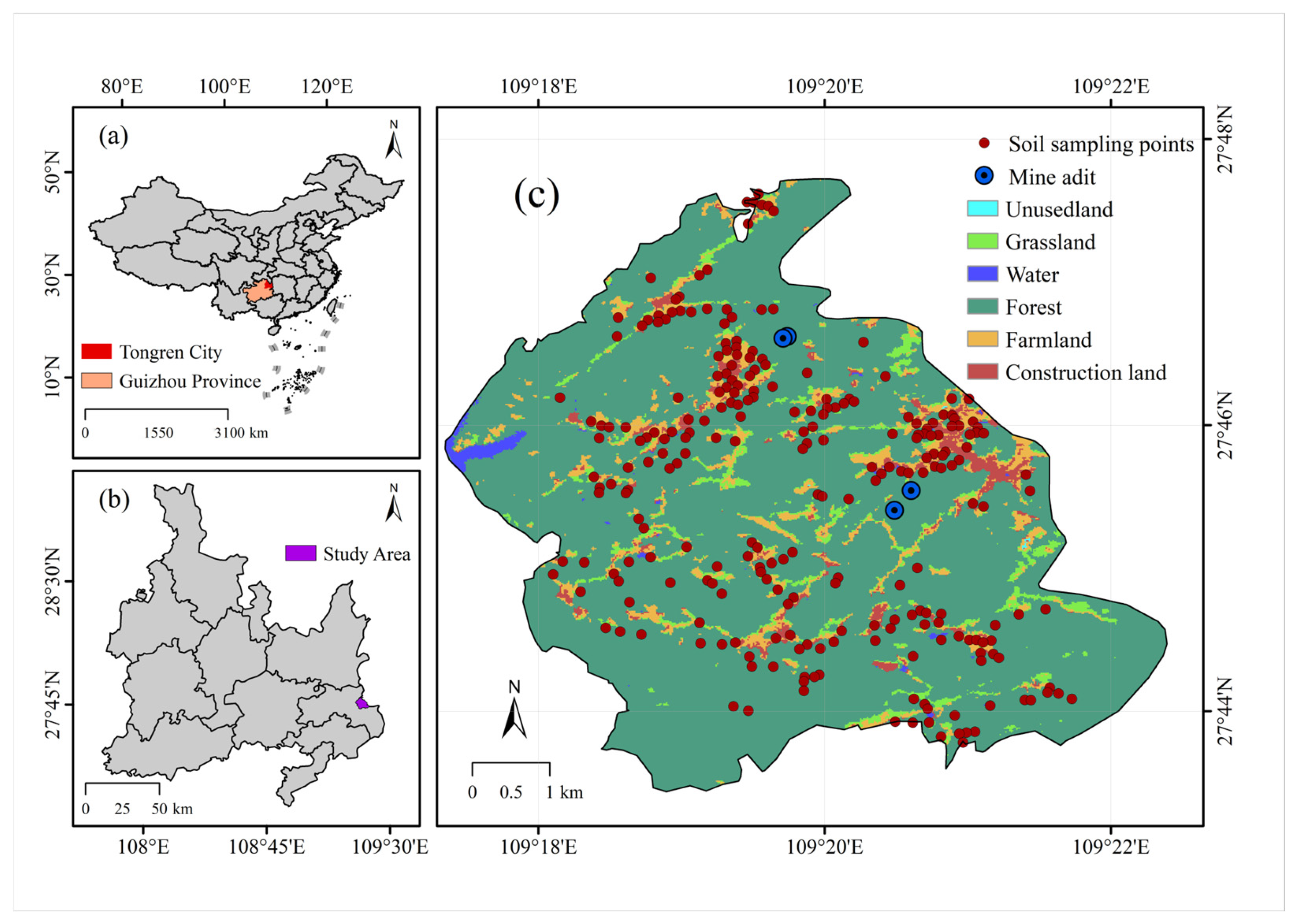
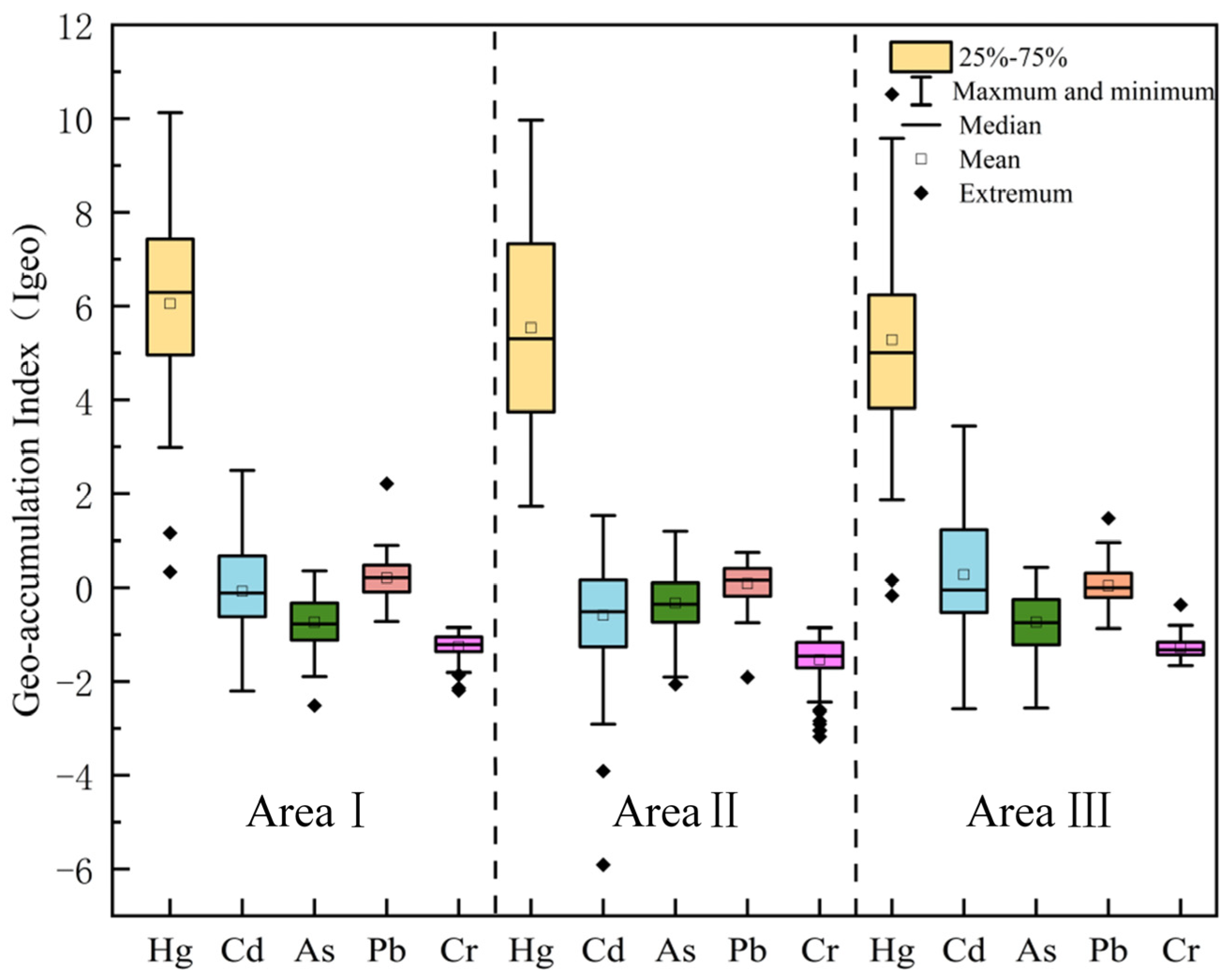
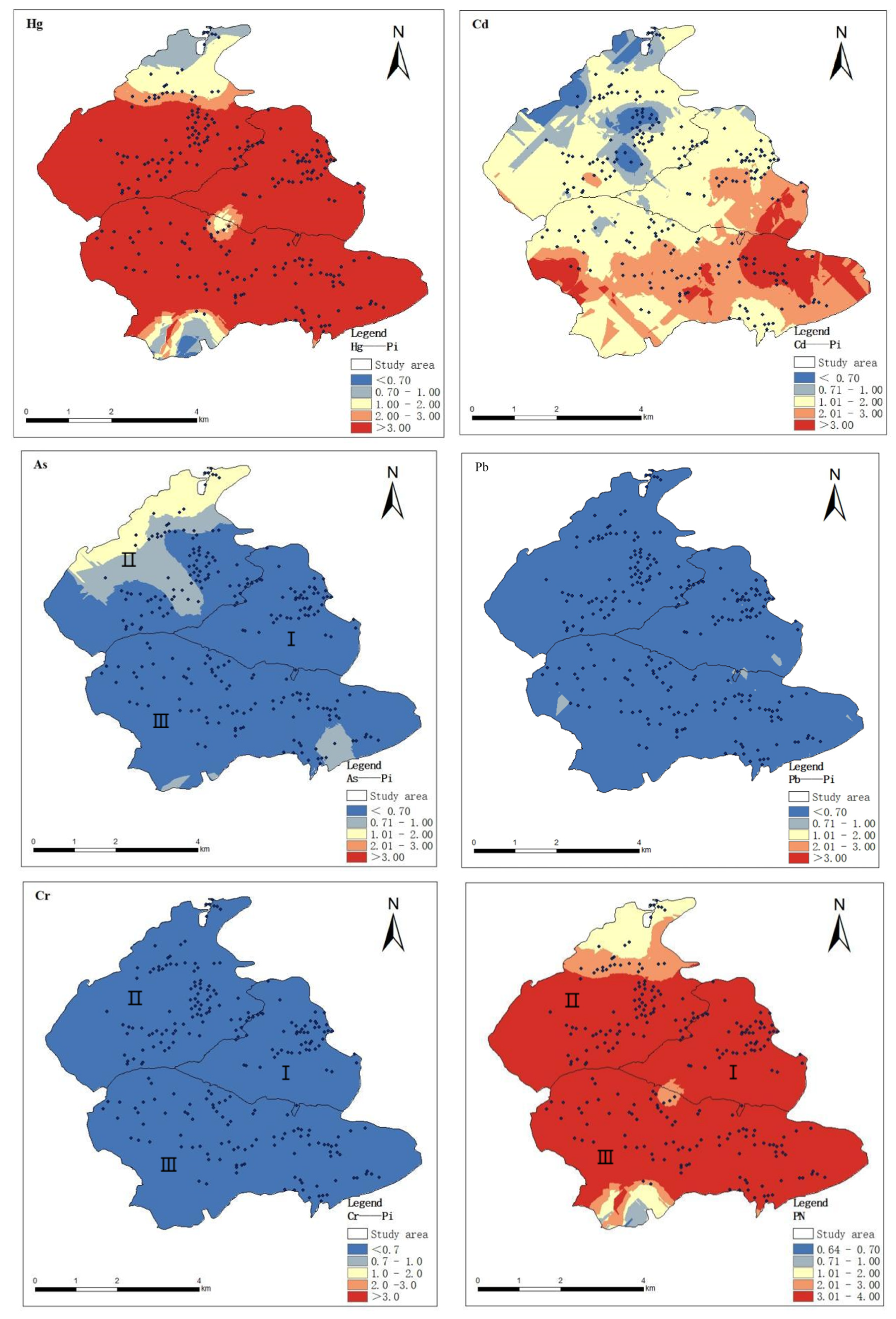
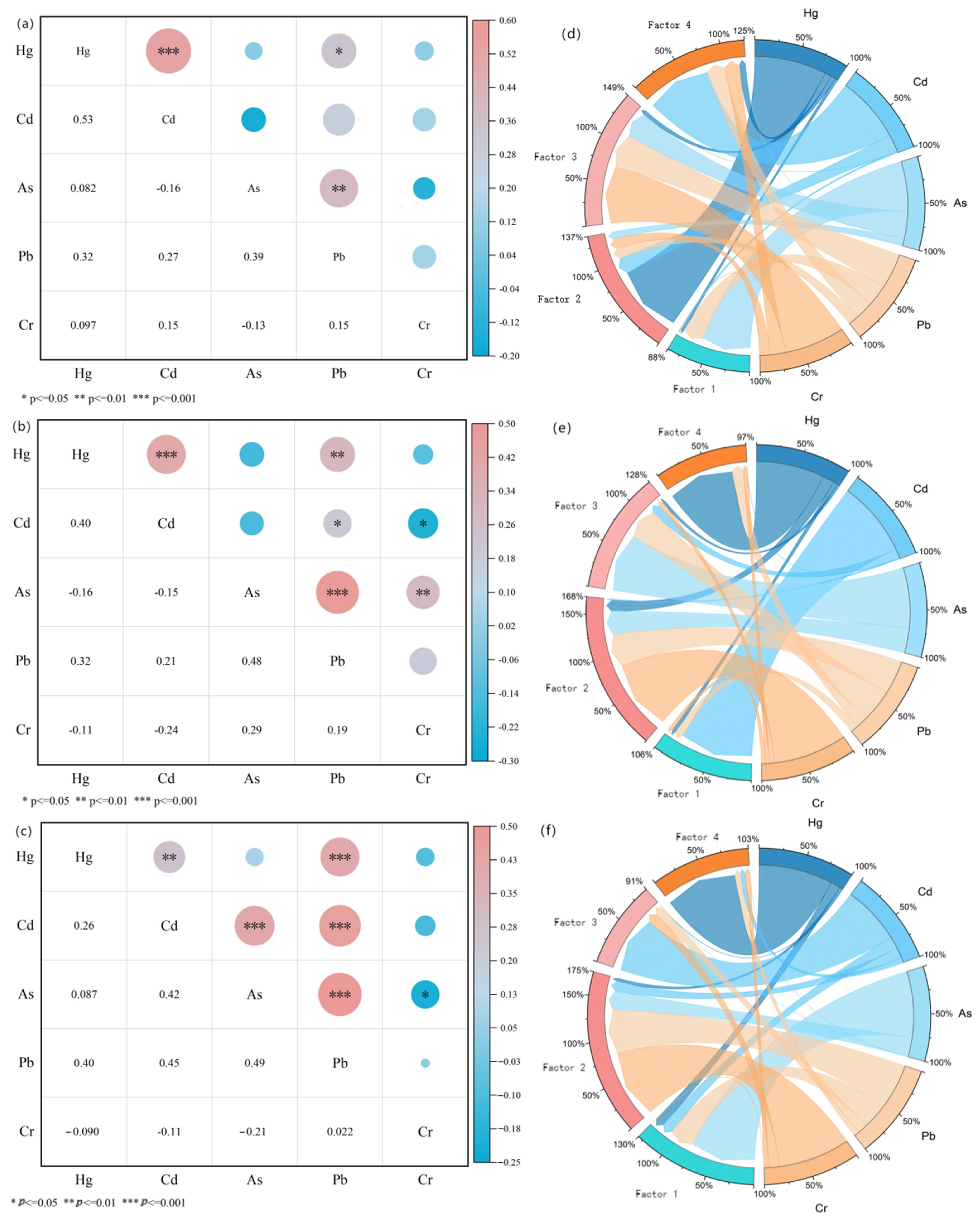
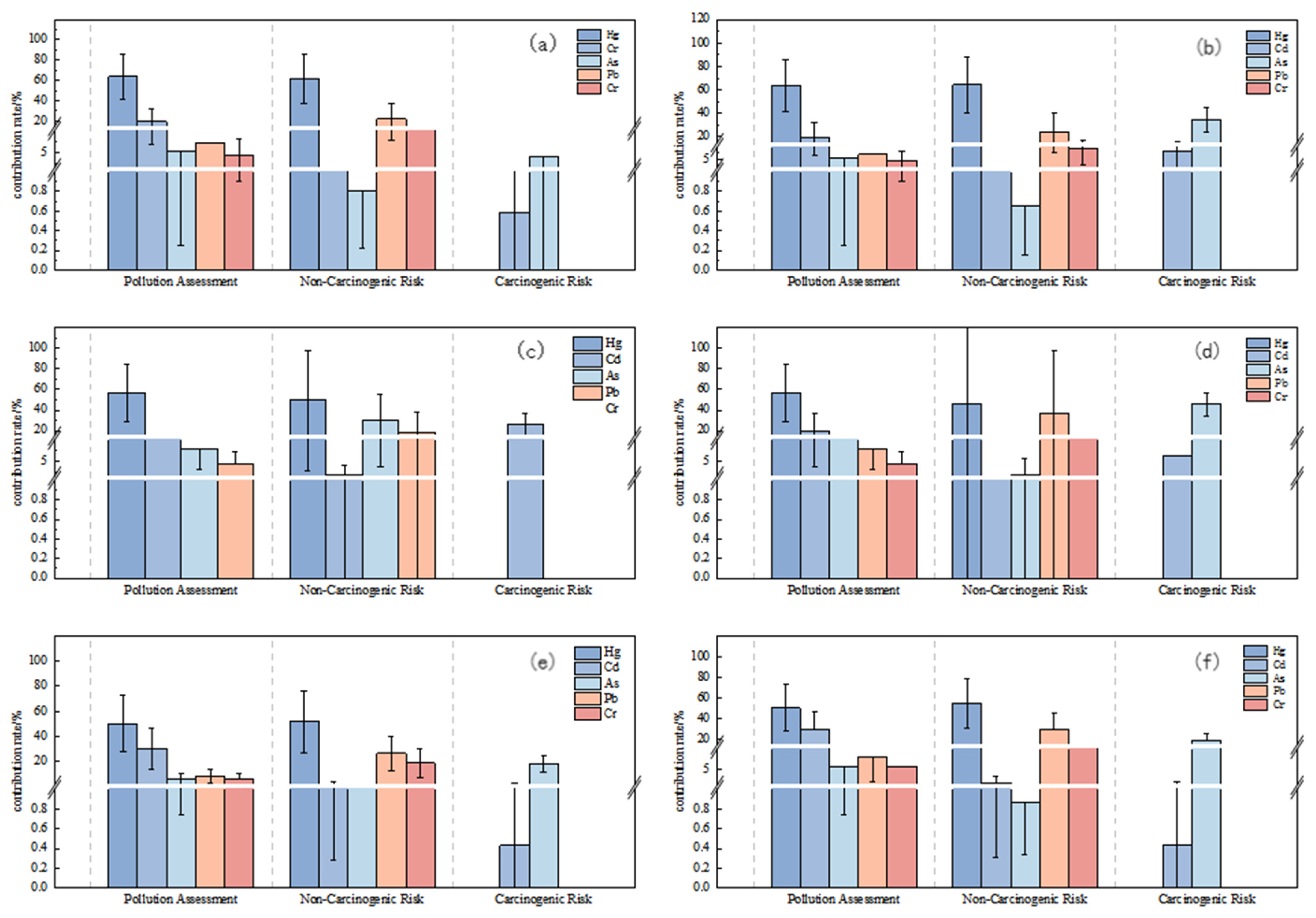
| Source | Area I | Area II | Area III |
|---|---|---|---|
| Mining activity | 27.4% | 15.9% | 16.9% |
| Smelting | 3.3% | 25.7% | 18.1% |
| Agricultural sources (pesticides; fertilizers) | 18.3% | 6.1% | 9.4% |
| Natural sources (soil-forming matrices, tailings impoundments, etc.) | 51.0% | 52.3% | 55.6% |
| Heavy Metals | Ingestion Pathway | Non-Carcinogenic Health Risk | |||||
|---|---|---|---|---|---|---|---|
| Adult | Children | ||||||
| I | II | III | I | II | III | ||
| Hg | Oral ingestion | 0.6 | 0.5 | 0.5 | 1.1 | 0.9 | 0.8 |
| Inhalation | 2.6 × 10−4 | 2.2 × 10−4 | 2.01 × 10−4 | 1.2 × 10−4 | 9.7 × 10−5 | 9.3 × 10−5 | |
| Dermal contact | 3.2 × 10−2 | 0.027 | 0.024 | 0.036 | 0.86 | 0.027 | |
| Cd | Oral ingestion | 4.9 × 10−3 | 3.4 × 10−3 | 7.3 × 10−3 | 8.8 × 10−3 | 6.2 × 10−3 | 0.013 |
| Inhalation | 2.1 × 10−4 | 1.4 × 10−4 | 4.9 × 10−4 | 9.5 × 10−5 | 6.7 × 10−5 | 5.5 × 10−4 | |
| Dermal contact | 6.9 × 10−4 | 4.9 × 10−4 | 1.0 × 10−3 | 9.5 × 10−5 | 5.6 × 10−4 | 1.2 × 10−3 | |
| As | Oral ingestion | 1.8 × 10−3 | 2.3 × 10−3 | 1.7 × 10−3 | 1.2 × 10−3 | 1.6 × 10−3 | 1.2 × 10−3 |
| Inhalation | 7.7 × 10−4 | 1.0 × 10−3 | 7.8 × 10−4 | 3.5 × 10−4 | 4.8 × 10−4 | 3.6 × 10−4 | |
| Dermal contact | 1.1 × 10−3 | 1.4 × 10−3 | 1.1 × 10−3 | 3.2 × 10−3 | 4.3 × 10−3 | 3.2 × 10−3 | |
| Pb | Oral ingestion | 0.10 | 9.4 × 10−2 | 9.1 × 10−2 | 0.19 | 0.17 | 0.16 |
| Inhalation | 8.5 × 10−6 | 7.6 × 10−6 | 7.4 × 10−6 | 3.9 × 10−6 | 3.5 × 10−6 | 3.4 × 10−6 | |
| Dermal contact | 4.2 × 10−4 | 3.8 × 10−4 | 3.7 × 10−4 | 4.8 × 10−4 | 4.3 × 10−4 | 4.2 × 10−4 | |
| Cr(III) | Oral ingestion | 2.86 × 10−4 | 6.1 × 10−5 | 2.8 × 10−6 | 5.1 × 10−4 | 1.1 × 10−4 | 4.9 × 10−4 |
| Inhalation | 8.7 × 10−6 | 6.2 × 10−7 | 8.5 × 10−6 | 2.8 × 10−4 | 1.9 × 10−5 | 2.7 × 10−4 | |
| Dermal contact | 9.6 × 10−2 | 5.1 × 10−2 | 5.8 × 10−2 | 6.8 × 10−2 | 5.7 × 10−2 | 6.6 × 10−2 | |
| THI | 0.7 | 0.7 | 0.6 | 1.2 | 1.21 | 1.14 | |
| Carcinogenic Health Risk | |||||||
| Cd | Oral ingestion | 1.5 × 10−6 | 1.8 × 10−5 | 3.7 × 10−5 | 7.8 × 10−6 | 4.9 × 10−6 | 1.0 × 10−5 |
| Inhalation | 1.7 × 10−11 | 1.2 × 10−11 | 2.5 × 10−11 | 2.7 × 10−11 | 1.7 × 10−11 | 3.6 × 10−11 | |
| Dermal contact | 5.3 × 10−9 | 6.3 × 10−8 | 1.3 × 10−7 | 2.0 × 10−6 | 3.4 × 10−8 | 7.0 × 10−8 | |
| As | Oral ingestion | 1.4 × 10−5 | 1.5 × 10−4 | 1.1 × 10−4 | 3.1 × 10−5 | 4.2 × 10−5 | 1.18 × 10−3 |
| Inhalation | 1.6 × 10−9 | 4.9 × 10−8 | 1.2 × 10−10 | 1.7 × 10−9 | 2.3 × 10−9 | 2.1 × 10−8 | |
| Dermal contact | 1.5 × 10−10 | 1.6 × 10−5 | 1.1 × 10−9 | 6.1 × 10−10 | 8.2 × 10−10 | 6.2 × 10−10 | |
| TCR | 1.6 × 10−5 | 1.7 × 10−5 | 1.5 × 10−4 | 4.3 × 10−5 | 4.7 × 10−5 | 4.2 × 10−5 | |
| Heavy Metals | Ingestion Pathway | Non-Carcinogenic Health Risk | |||||
|---|---|---|---|---|---|---|---|
| Adult | Children | ||||||
| I | II | III | I | II | III | ||
| Hg | Oral ingestion | 85.5% | 84.2% | 82.8% | 84.9% | 83.3% | 83.1% |
| Inhalation | 21.0% | 15.5% | 13.5% | 14.2% | 10.9% | 7.2% | |
| Dermal contact | 24.6% | 33.7% | 28.3% | 33.6% | 93.2% | 27.7% | |
| Cd | Oral ingestion | 0.7% | 0.6% | 1.3% | 0.7% | 0.6% | 1.3% |
| Inhalation | 16.4% | 10.3% | 33.2% | 11.1% | 7.6% | 43.4% | |
| Dermal contact | 0.5% | 0.6% | 1.2% | 0.1% | 0.1% | 1.2% | |
| As | Oral ingestion | 0.2% | 0.4% | 0.3% | 0.1% | 0.1% | 0.1% |
| Inhalation | 61.2% | 73.2% | 52.3% | 41.3% | 54.2% | 27.9% | |
| Dermal contact | 0.8% | 1.8% | 1.3% | 2.9% | 0.5% | 3.3% | |
| Pb | Oral ingestion | 13.6% | 14.9% | 15.7% | 14.3% | 15.9% | 15.5% |
| Inhalation | 0.7% | 0.5% | 0.5% | 0.5% | 0.4% | 0.3% | |
| Dermal contact | 0.3% | 0.5% | 0.4% | 0.4% | 0.0% | 0.4% | |
| Cr | Oral ingestion | 0.0% | 0.0% | 0.0% | 0.0% | 0.0% | 0.0% |
| Inhalation | 0.7% | 0.5% | 0.6% | 32.9% | 27.0% | 21.3% | |
| Dermal contact | 73.7% | 63.4% | 68.7% | 62.9% | 6.2% | 67.4% | |
| Carcinogenic Health Risk | |||||||
| Cd | Oral ingestion | 4.6% | 5.6% | 11.7% | 8.8% | 5.5% | 0.8% |
| Inhalation | 0.0% | 0.0% | 0.0% | 0.0% | 0.0% | 0.0% | |
| Dermal contact | 57.9% | 0.1% | 75.5% | 98.9% | 62.9% | 0.2% | |
| As | Oral ingestion | 43.1% | 47.2% | 34.7% | 34.9% | 46.9% | 95.2% |
| Inhalation | 2.2% | 17.5% | 0.2% | 1.0% | 2.4% | 5.4% | |
| Dermal contact | 1.6% | 22.0% | 0.6% | 0.0% | 1.5% | 0.0% | |
Disclaimer/Publisher’s Note: The statements, opinions and data contained in all publications are solely those of the individual author(s) and contributor(s) and not of MDPI and/or the editor(s). MDPI and/or the editor(s) disclaim responsibility for any injury to people or property resulting from any ideas, methods, instructions or products referred to in the content. |
© 2025 by the authors. Licensee MDPI, Basel, Switzerland. This article is an open access article distributed under the terms and conditions of the Creative Commons Attribution (CC BY) license (https://creativecommons.org/licenses/by/4.0/).
Share and Cite
Wang, S.; Guo, Y.; Hu, H.; Liang, Y.; Li, K.; Zhang, K.; Hou, G.; Li, C.; Zhang, J.; Wang, Z. Sources, Distribution, and Health Risks of Heavy Metal Contamination in the Tongren Mercury Mining Area: A Case Study on Mercury and Cadmium. Toxics 2025, 13, 527. https://doi.org/10.3390/toxics13070527
Wang S, Guo Y, Hu H, Liang Y, Li K, Zhang K, Hou G, Li C, Zhang J, Wang Z. Sources, Distribution, and Health Risks of Heavy Metal Contamination in the Tongren Mercury Mining Area: A Case Study on Mercury and Cadmium. Toxics. 2025; 13(7):527. https://doi.org/10.3390/toxics13070527
Chicago/Turabian StyleWang, Shuo, Yani Guo, Huimin Hu, Yingqi Liang, Kun Li, Kuifu Zhang, Guiqiong Hou, Chunhai Li, Jiaxun Zhang, and Zhenxing Wang. 2025. "Sources, Distribution, and Health Risks of Heavy Metal Contamination in the Tongren Mercury Mining Area: A Case Study on Mercury and Cadmium" Toxics 13, no. 7: 527. https://doi.org/10.3390/toxics13070527
APA StyleWang, S., Guo, Y., Hu, H., Liang, Y., Li, K., Zhang, K., Hou, G., Li, C., Zhang, J., & Wang, Z. (2025). Sources, Distribution, and Health Risks of Heavy Metal Contamination in the Tongren Mercury Mining Area: A Case Study on Mercury and Cadmium. Toxics, 13(7), 527. https://doi.org/10.3390/toxics13070527









